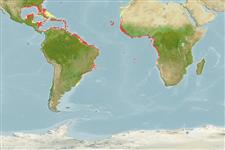Common names from other countries
>
Eupercaria/misc (Various families in series Eupercaria) >
Gerreidae (Mojarras)
Etymology: Eucinostomus: Greek, eu = good + Greek, kyon = dog + Greek, stoma = mouth (Ref. 45335).
More on author: Bleeker.
Environment: milieu / climate zone / depth range / distribution range
Ecologia
marinhas; Água doce; estuarina demersal; anfídromo (Ref. 51243); intervalo de profundidade 0 - 25 m (Ref. 2683). Subtropical; 33°N - 34°S, 98°W - 14°E
Eastern Atlantic: west African coast, from Senegal to Angola (Ref. 57394). Also reported from Mauritania (Ref. 5377, 7352). Western Atlantic: Bermuda and Florida, USA to Brazil; not found in the Bahamas (Ref. 7251).
Tamanho / Peso / Idade
Maturity: Lm ? range ? - ? cm
Max length : 30.0 cm TL macho/indeterminado; (Ref. 2683); common length : 23.0 cm TL macho/indeterminado; (Ref. 2683); peso máx. publicado: 26.50 g (Ref. 118626)
Espinhos dorsais (total) : 9; Raios dorsais (total) : 10; Espinhos anais: 3; Raios anais : 7 - 8. Diagnosis: body fusiform and compressed; snout pointed; mouth strongly protrusible; nostrils contiguous, positioned nearer to eye than to snout tip; dorsal fin deeply notched; tips of pectoral fins not reaching to anal-fin origin; scales cycloid on head and finely ctenoid on body; scales of interocular space reaching anterior border of eyes; tip of spinous dorsal fin with a black spot, underlined by a whitish band (Ref. 57394).
Coloration: back olivaceous, sides silvery; a characteristic black spot at tip of spiny part of dorsal fin; young individuals may show dark vertical bars on back and sides (Ref. 57394).
A coastal species entering estuaries, lower courses of coastal rivers, and lagoons (Ref. 4323, 7352, 57394). Found over sand or mud bottoms (Ref. 3722, 57394). Feeds on fish, shrimps, mollusks, zooplankton and detritus (Ref. 28587); including other benthic crustaceans and polychaetes. Forages at daytime in small groups, hovering close to the bottom and either picks off prey on the substrate or digs into it sifting the mouthed sediment through its opercular openings. Its conspicuous black tip on dorsal fin is mimicked by juvenile guianan snooks, Centropomus mexicanus, an example of aggressive mimicry (Ref. 43465). Marketed fresh but not highly esteemed (Ref. 3722).
Ciclo de vida ou comportamento de acasalamento
Maturities | Reprodução | Spawnings | Egg(s) | Fecundities | Larvas
Roux, C., 1990. Gerridae. p. 781-782. In J.C. Quero, J.C. Hureau, C. Karrer, A. Post and L. Saldanha (eds.) Check-list of the fishes of the eastern tropical Atlantic (CLOFETA). JNICT, Lisbon; SEI, Paris; and UNESCO, Paris. Vol. 2. (Ref. 7352)
Status na Lista Vermelha da UICN (Ref. 130435)
CITES (Ref. 128078)
Not Evaluated
Ameaça para os humanos
Harmless
Uso pelos humanos
Pescarias: pouco comercial
Ferramentas
Relatórios especiais
Baixar XML
Fontes da internet
Estimates based on models
Preferred temperature (Ref.
115969): 23.4 - 28, mean 27.1 (based on 1079 cells).
Índice de diversidade filogenética (Ref.
82804): PD
50 = 0.5010 [Uniqueness, from 0.5 = low to 2.0 = high].
Bayesian length-weight: a=0.01047 (0.00829 - 0.01322), b=3.08 (3.04 - 3.12), in cm Total Length, based on LWR estimates for this species (Ref.
93245).
Nível Trófico (Ref.
69278): 3.2 ±0.45 se; based on food items.
Resiliência (Ref.
120179): Elevada, tempo mínimo de duplicação da população menor que 15 meses (Preliminary K or Fecundity.).
Fishing Vulnerability (Ref.
59153): Low vulnerability (20 of 100).
